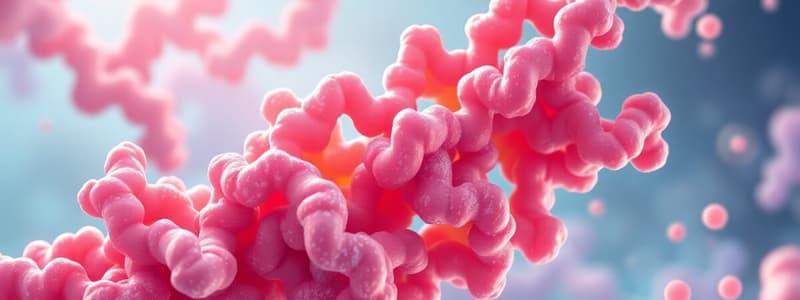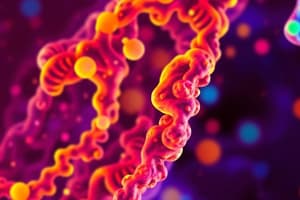Podcast
Questions and Answers
Which type of proteins is characterized by a long, fibrous structure and is often insoluble in water?
Which type of proteins is characterized by a long, fibrous structure and is often insoluble in water?
- Simple proteins
- Conjugated proteins
- Fibrous proteins (correct)
- Globular proteins
What is a primary function of proteins in the body?
What is a primary function of proteins in the body?
- Storing genetic information
- Building and repairing tissues (correct)
- Providing structural support for cells
- Transmitting nerve signals
Which of the following statements is true regarding essential amino acids?
Which of the following statements is true regarding essential amino acids?
- They are only found in animal products.
- They can be synthesized by the body.
- They have a negative impact on protein synthesis.
- They must be obtained from the diet. (correct)
What describes the tertiary structure of a protein?
What describes the tertiary structure of a protein?
What role do emulsifiers play in food chemistry?
What role do emulsifiers play in food chemistry?
Which class of proteins contains a non-protein component, such as a metal ion or lipid?
Which class of proteins contains a non-protein component, such as a metal ion or lipid?
What are the building blocks of proteins?
What are the building blocks of proteins?
Which part of the amino acid structure is responsible for its unique properties?
Which part of the amino acid structure is responsible for its unique properties?
Which property of carbohydrates indicates the different spatial arrangements of atoms in molecules with the same structural formula?
Which property of carbohydrates indicates the different spatial arrangements of atoms in molecules with the same structural formula?
What is the simplest unit of a carbohydrate known as?
What is the simplest unit of a carbohydrate known as?
What type of carbohydrate consists of long chains of monosaccharides?
What type of carbohydrate consists of long chains of monosaccharides?
Which of the following reactions occurs when monosaccharides oxidize to form carboxylic acids?
Which of the following reactions occurs when monosaccharides oxidize to form carboxylic acids?
What distinguishes phospholipids from other lipids?
What distinguishes phospholipids from other lipids?
How are phenylhydrazine and carbohydrates related in chemical reactions?
How are phenylhydrazine and carbohydrates related in chemical reactions?
What distinguishes reducing sugars in carbohydrates?
What distinguishes reducing sugars in carbohydrates?
Which type of lipid primarily exists in animal sources and includes an ester of long-chain fatty acids?
Which type of lipid primarily exists in animal sources and includes an ester of long-chain fatty acids?
What type of lipids are formed from the condensation of isoprene units?
What type of lipids are formed from the condensation of isoprene units?
What term describes the presence of two isomers of glucose with respect to the penultimate carbon atom?
What term describes the presence of two isomers of glucose with respect to the penultimate carbon atom?
What is the term for the ring structure formed in certain carbohydrates when the first carbon condenses with the -OH group of the fifth carbon?
What is the term for the ring structure formed in certain carbohydrates when the first carbon condenses with the -OH group of the fifth carbon?
Which structure defines sphingolipids in the lipid classification?
Which structure defines sphingolipids in the lipid classification?
Which lipids are primarily known for making up more than 95 percent of dietary fats?
Which lipids are primarily known for making up more than 95 percent of dietary fats?
Derived lipids are primarily known for which of the following roles?
Derived lipids are primarily known for which of the following roles?
Which type of lipid classification includes triglycerides, waxes, and ceramides?
Which type of lipid classification includes triglycerides, waxes, and ceramides?
What is the main functional property of sterols in comparison to other lipids?
What is the main functional property of sterols in comparison to other lipids?
Flashcards
Phospholipids
Phospholipids
Essential for cell membrane structure.
Carbohydrates
Carbohydrates
Organic compounds with a 1:2:1 ratio of C:H:O.
Monosaccharide
Monosaccharide
Simplest unit of a carbohydrate.
Glucose
Glucose
Signup and view all the flashcards
Fast-releasing Carbs
Fast-releasing Carbs
Signup and view all the flashcards
Slow-releasing Carbs
Slow-releasing Carbs
Signup and view all the flashcards
Stereoisomers
Stereoisomers
Signup and view all the flashcards
Optical Activity
Optical Activity
Signup and view all the flashcards
Essential Amino Acids
Essential Amino Acids
Signup and view all the flashcards
Protein Degradation
Protein Degradation
Signup and view all the flashcards
Emulsion
Emulsion
Signup and view all the flashcards
Emulsifiers
Emulsifiers
Signup and view all the flashcards
Hydrophobic
Hydrophobic
Signup and view all the flashcards
Hydrophilic
Hydrophilic
Signup and view all the flashcards
Primary Protein Structure
Primary Protein Structure
Signup and view all the flashcards
Secondary Protein Structure
Secondary Protein Structure
Signup and view all the flashcards
Unsaturated Fatty Acids
Unsaturated Fatty Acids
Signup and view all the flashcards
Glycolipids
Glycolipids
Signup and view all the flashcards
Sterols
Sterols
Signup and view all the flashcards
Simple Lipids
Simple Lipids
Signup and view all the flashcards
Complex Lipids
Complex Lipids
Signup and view all the flashcards
Derived Lipids
Derived Lipids
Signup and view all the flashcards
Triacylglycerols
Triacylglycerols
Signup and view all the flashcards
Study Notes
Food Proteins
- Essential macronutrients, composed of amino acids
- Vital for bodily functions
Protein Degradation
- Natural process breaking proteins into amino acids
- Ensures cellular quality control and homeostasis
- Ubiquitin-proteasome pathway and autophagy-lysosome pathway are primary mechanisms
Emulsions
- Mixtures of two or more immiscible liquids
- Stabilized by emulsifiers, preventing separation
Amino Acids
- Essential amino acids cannot be produced by the body and must be obtained from the diet
- Non-essential amino acids can be produced by the body
- Amino acids have an amino group (-NH2), a carboxyl group (-COOH), and a side chain (R group)
Protein Structure
- Primary: Linear sequence of amino acids in a polypeptide chain
- Secondary: Local folding patterns (alpha-helices and beta-sheets) stabilized by hydrogen bonds
- Tertiary: Three-dimensional shape of a single polypeptide chain, determined by side chain interactions
- Quaternary: Arrangement of multiple polypeptide chains to form a functional protein complex
Protein Classification
- Globular: Spherical, often soluble in water (enzymes, hormones, antibodies)
- Fibrous: Long, fibrous, often insoluble in water (collagen, keratin, elastin)
- Simple: Composed only of amino acids
- Conjugated: Contain a non-protein component (metal ion, lipid, carbohydrate)
Lipid Degradation (Rancidity)
- Undesirable changes over time, leading to quality deterioration
- Primarily driven by hydrolysis and oxidation, altering lipid structure and properties
Types of Lipid Degradation
- Hydrolysis: Lipid breakdown by water, releasing free fatty acids and glycerol
- Oxidation: Lipid reaction with oxygen, forming free radicals and oxidation products
- Polymerization: Lipid molecules reacting to form polymers, affecting viscosity and texture
- Isomerization: Rearranging double bonds in unsaturated fatty acids, changing melting point and reactivity
- Photolysis: Lipid breakdown by light, forming free radicals and degradation products
Lipid Technology: Refinement and Modification
- Degumming: Removing non-lipid impurities
- Neutralization: Removing free fatty acids
- Bleaching: Removing pigments
- Deodorization: Removing off-flavors
- Hydrogenation: Converting unsaturated to saturated fatty acids (increasing melting point and stability)
- Interesterification: Rearranging fatty acids within triglycerides (altering melting point and texture)
- Fractionation: Separating lipids into fractions by controlled crystallization
- Enzymatic Modification: Using enzymes to selectively modify lipids
Lipids in Food
- Flavor and texture: Dissolving flavor molecules, creating smooth/creamy textures
- Satiety: Contributing to feelings of fullness
- Cooking and Baking: Heat transfer medium, influencing food texture
Lipid Structure
- Fatty acids: Saturated or unsaturated, depending on presence of double bonds
- Phospholipids: Glycerol backbone with two fatty acids and a phosphate group
- Glycolipids: Glycerol backbone with one or two fatty acids and a carbohydrate group
- Sterols: Four-ring structure and a hydroxyl group
- Waxes: Esters of long-chain fatty acids and long-chain alcohols
Carbohydrates
- Glucose is the most abundant carbohydrate, with 6 carbon atoms.
- Classified into fast-releasing and slow-releasing types.
- Monosaccharides include glucose, fructose, and galactose
- Dissacharides include lactose, maltose, and sucrose
Carbohydrate Structure
- Open chain: Long straight-chain form
- Hemi-acetal: Cyclized structure
- Haworth: Ring structure of carbohydrates
Carbohydrate Physical Properties
- Stereoisomers: Compounds with the same chemical formula but different spatial arrangement
- Optical activity: Rotation of plane-polarized light, forming (+) and (-) glucose
- Diastereoisomers: Configurational changes concerning C2, C3, or C4 on glucose
- Annomerism: Spatial configuration concerning the first carbon atom on aldoses and the second carbon on ketoses
Carbohydrate Chemical Properties
- Osazone formation: Reaction with phenylhydrazine to produce osazones
- Oxidation: Monosaccharides acting as reducing sugars, converting carbonyl groups to carboxylic acids
Functional Protein Properties in Food
- Water absorption and retention
- Solubility
- Color (Maillard reaction)
- Gelation
- Viscosity and texture
- Emulsification
- Foam formation
- Flavor binding
- Curdling
- Enzymatic Browning: non-enzymatic browning caused by the action of an enzyme (polyphenol oxidase) which oxidizes phenol compounds in food in the presence of oxygen leading to a brown product called melanin.
Denaturation
- Proteins losing their quaternary, tertiary, and secondary structure under certain conditions: strong acids/bases, high temperature, organic solvents, radiation etc
Studying That Suits You
Use AI to generate personalized quizzes and flashcards to suit your learning preferences.




